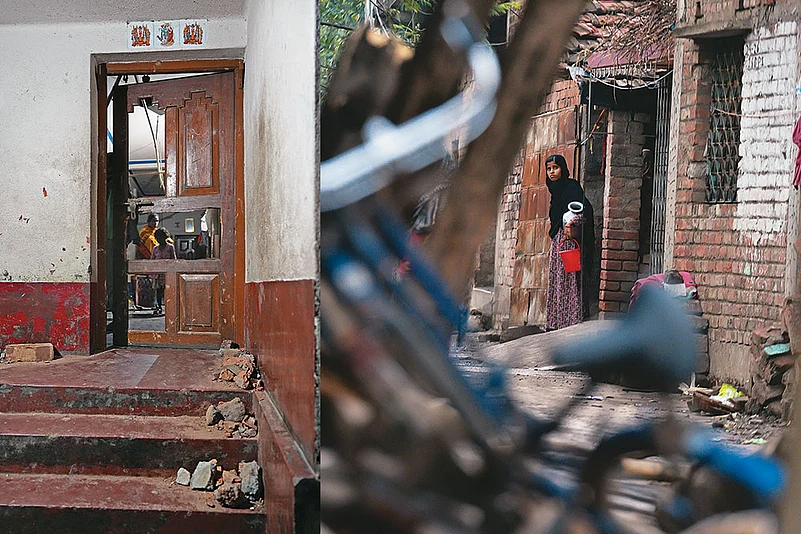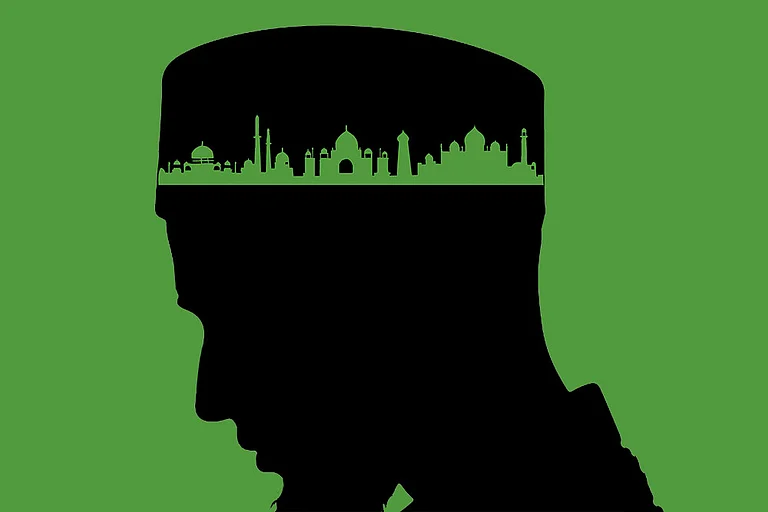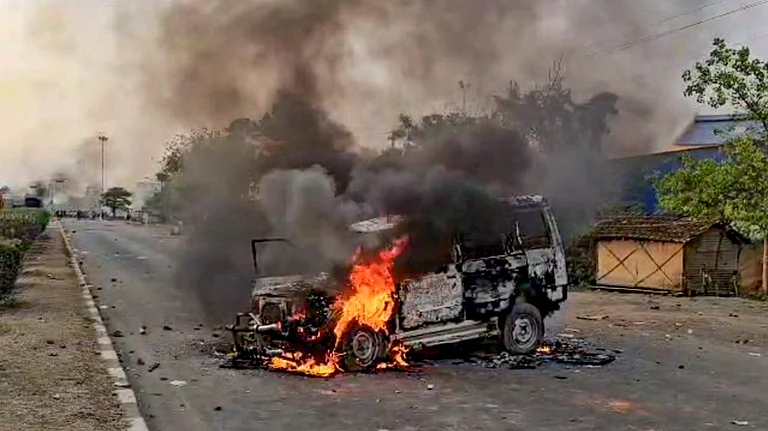Shankar Pal라이브 바카라 modest two-storied house stands ruined on one side of the narrow lane. Burnt and broken items are heaped outside—parts of a TV set, a refrigerator door. The house doors are open. The window grills broken. Inside, the shelves and wardrobes lay in pieces. Next to the house, shops owned by Nitya Pal and Narayan Pal are gutted. A silvery shine from dumped cooking utensils darkly glints from a dry and dirty pond nearby.
Life is no longer normal at Dighori Palpara, where most houses are one-storied. This is a neighbourhood marked by visible economic backwardness. The Pal families left their homes on the evening of April 12, when the Border Security Force personnel came to rescue them over five hours after the attack. The empty houses seemingly imposed an uneasy quiet on the locality. People still speak in hushed tones.
The district is Murshidabad, which hosts India라이브 바카라 largest Muslim population—47 lakh, as per the 2011 census. They form two-thirds of the district라이브 바카라 population. Muslims had been protesting in different neighbouring areas since President Droupadi Murmu gave her assent to the Waqf (Amendment) Bill, 2025, on April 5. Protesters had clashed with the police on highways and streets and vandalised public properties. Two Muslim youths were critically injured in police firing at a place a few kilometres away the previous evening.
But at Dighori, Zafrabad, Ranipul and Bedbona, none sensed any danger at home. Here, Hindus and Muslims live so close to each other that it is impossible to tell a Hindu household from a Muslim one from outside without prior knowledge. They lived peacefully. Yet, the mobs that descended on these neighbourhoods on the morning of April 12 selectively targeted Hindu houses.
Inspite of the ‘outsider’ theories, the selective targeting of Hindu properties in mixed population areas bears signs of locals’ involvement.
That morning, people at the impoverished, semi-urban neighbourhoods of Dighori, Zafrabad, Ranipul and Bedbona in central West Bengal were busy with their usual routine work at home and outside. Suddenly, all hell broke loose as mobs of dozens of Muslim youths entered these neighbourhoods almost simultaneously at around 9 to 10 am, armed with sharp-edged weapons, petrol bombs and small firearms.
What happened over the next few hours has scarred Dhulian— the municipal town where all these places are located—so deeply that healing would require much time and effort. About four-fifths of the town라이브 바카라 population is Muslim and the rest, Hindus. In many localities of Dhulian, a handful of Hindu houses stand surrounded by Muslim homes. But the mutual communal trust that worked fine for several decades is broken. The implications go far beyond the localities.
Around 10 am on April 12, Muslim boys and young men, estimated to be 15/16 and 20/22 years old, entered these localities carrying sharp weapons, small firearms and glass bottles. They had covered their faces with black clothes. The mob did not raise any slogans. They entered Hindu households, carried out vandalism, looted cash and jewellery and set fire to several houses and shops. From one such home at Zafrabad, they dragged out a father-son duo, Haragobindo (71) and Chandan Das (41), and hacked them to death.
The news of these murders and the death of Ejaz Ahmed, one of the Muslim youths injured in police firing, and bullet injuries to six more Muslim youths, led to more clashes on April 13, even as the government had already deployed central paramilitary forces. Nearly two dozen security personnel suffered injuries during the four to five days of protests in Samsherganj, Suti and Jangipur police station areas in Murshidabad districts as well as in part of neighbouring Malda.
Over 300 Hindu families left their homes on April 12 and 13. Some have taken shelter at a High School in Par Lalpur in Malda district on the other side of the Ganga. Some are staying at their relatives’ homes. A few of those who fled returned around April 16 and 17, but several families have kept women and children away. Many Muslims have also left their homes, fearing ‘indiscriminate arrest’ by the police and paramilitary forces. Some of their homes and businesses were burnt.
“When the mob started the attack, we, the locals, tried to resist. But they threatened us too. They were armed. We were all scared,” says Abdul Halim, a Dighori Sahapara resident. Anwara Bibi of Dighori Palpara echoes him. They feel ashamed that they failed to protect their Hindu neighbours.
Dhulian stands close to India라이브 바카라 border with Bangladesh and West Bengal라이브 바카라 border with Bihar and Jharkhand. The location led to the emergence of many conspiracy theories involving ‘outsiders.’ The Rashtriya Swayamsevak Sangh (RSS) affiliated organisations, including the BJP–Bengal라이브 바카라 main opposition party—alleged that Muslim fundamentalist and terrorist elements from Bangladesh were involved. The state라이브 바카라 ruling party and Leftist forces alleged the BJP had brought in ‘outsiders’ from Bihar and Jharkhand.
Due to the unexpectedness of the incidents, people suspect many conspiracies. There have been talks of provocative speeches from Ram Navami and Hanuman Jayanti rallies. Some believe in the involvement of Muslim hardline organisations who are keeping a low profile. Others blame the infiltration of criminals into the anti-waqf protests. Irrespective of the various ‘outsider’ theories, the selective targeting of Hindu properties in a mixed population areas bears telltale signs of the locals’ involvement. And this takes away the comfort of trust.
A Setback
Muslims and secular organisations are carrying out protests against the new Waqf law in many states. Politicians from the Congress, the Trinamool Congress (TMC), the Communist Party of India (Marxist), the Dravida Munnetra Kazhagam (DMK) and the All India Majlis Ittehad e Muslimeen (AIMIM) have challenged the law in the Supreme Court. While some incidents of violence happened in Assam and Tripura of northeast India—both BJP-ruled states—they were confined to the streets and in clashes with the security forces.
In Bengal, violence in neighbourhoods and communal targeting has turned the tables on the Muslims, who are claiming to be victims of the BJP government라이브 바카라 communally divisive politics. Uttar Pradesh Chief Minister ‘Yogi’ Adityanath of the BJP questioned the opposition parties’ silence on the Murshidabad violence. The Supreme Court, too, expressed deep concerns over continued violence at a time the top court was considering legal challenges.
Dhulian emerged as a great divider, a strong polariser in a state where Muslims form more than one-fourth of the population, a state that many Muslims hoped could spearhead the anti-waqf protests, being the only opposition-ruled state with a large Muslim population. It also has over 80,480 waqf properties—second only to Uttar Pradesh라이브 바카라 2.2 lakh. But the chain of events has rekindled Bengal라이브 바카라 old wound of communal tension, widening a politically polarising social division.

The violence is perplexing to a certain extent, as the state라이브 바카라 ruling party, Mamata Banerjee라이브 바카라 Trinamool Congress (TMC), had opposed the Bill in the parliament. TMC parliamentarian Mahua Moitra was the first politician to challenge the new law in the Supreme Court, followed by the CPI(M) state secretary Mohammad Salim. CM Banerjee announced that her government would not implement the law in the state. Yet, TMC minister Siddiqullah Chowdhury, who also heads the state chapter of Jamiat Ulema-e-Hind, threatened to bring Kolkata라이브 바카라 traffic to a standstill by imposing a hundred blockades.
Apart from Dhulian, street violence erupted during protests in many other places in the state. Protests on highways in South 24 Parganas in southern Bengal and Malda in northern Bengal—districts with India라이브 바카라 second-largest (29 lakh) and fourth-largest (20 lakh) Muslim populations, respectively—led to clashes with the police and vandalism and burning of vehicles and roadside properties of the commoners.
What became evident from the Bengal protests is a lack of awareness among a large section of protesters about what they were protesting against.
These incidents have caused a setback to the community라이브 바카라 protest against the new Waqf law. A planned centralised gathering in Kolkata라이브 바카라 Brigade Parade Ground has been called off. Hindu nationalists have intensified their campaign that West Bengal is transforming into ‘West Bangladesh’—an analogy they use to mean Hindus are never safe where Muslims are in the majority. TV news channels, social media content, YouTube commentaries and roadside tea stall talks reflect an outburst of Islamophobia, linking the Dhulian incidents with the recent rise of Muslim fundamentalist forces in Bangladesh. Viral videos show Hindu victims calling for governance in the style of Adityanath.
“Consider how Muslims dare not turn to violence in Yogi라이브 바카라 Uttar Pradesh and see how Assam ended violence promptly. But here, the TMC government라이브 바카라 vote bank politics has allowed Muslims to hold the administration to ransom,” says Gobinda Ghosh, a resident of Dhulian Ghoshpara, one of the violence-hit localities.
Overall, the attack on Hindu homes and the killing of two have given a fillip to the BJP라이브 바카라 strategy for intensifying polarisation on communal lines and energising Hindu voters to ensure higher voter turnouts for a 7 to 8 per cent increase in vote share required for toppling the Mamata Banerjee government in the assembly elections due in about a year.
“This is Modi and Didi라이브 바카라 fixed game,” says Md. Asif Iqbal Hussain, a schoolteacher at Dhulian associated with the Congress, referring to Prime Minister Narendra Modi and West Bengal chief minister Mamata Banerjee. “Modi brought the law to provoke Muslims and Didi allowed Muslims to behave in an unruly manner. Why didn’t the Dhulian police respond quickly when Hindu families were making frantic phone calls, urging them to come to their rescue?” he asks.
If communal polarisation over Muslims’ protests is part of the BJP라이브 바카라 plan, as its opposition parties allege, then the state of Bihar holds even more urgency for them. The assembly elections are due later next year. The Seemanchal region of eastern Bihar that shares its borders with West Bengal라이브 바카라 Muslim-majority districts of Murshidabad, Malda and Uttar Dinajpur, has a high concentration of Muslim population.
While the state라이브 바카라 main opposition parties, the Rashtriya Janata Dal (RJD), the Congress and the Left parties are leading anti-waqf law protests, the BJP has started targeting them, citing Murshidabad violence. When RJD leader Tejaswi Yadav promised that the law would not be implemented in the state if they are voted to power, BJP leader and Union minister Giriraj Singh asked whether the opposition wanted to turn Bihar into Bengal.
“The message that the BJP is trying to spread across the country, citing the Murshidabad violence, is that Hindus are safe only under BJP rule,” says a Bengal Congress leader, who does not wish to be named.
What became evident from the Bengal protests is a lack of awareness among a large section of protesters about what they were protesting against. According to Sabir Ahamed, Senior Research Coordinator at the Kolkata-based Pratichi Trust, one of the main reasons behind the socio-political polarisation around the anti-Waqf bill protests is that neither political parties nor Muslim organisations made any serious attempts to build awareness on the new law, both within the community and among the Hindus, during the months preceding its passage in the parliament.
“This has led to a situation where the majority of the Hindus have no understanding of what harm the law does to the community and what the protests are all about. Similarly, there is a great lack in understanding within the community, which is why many of the protesters do not know what they are protesting against,” he says.
Snigdhendu Bhattacharya is a journalist, author and researcher
This article is part of 바카라라이브 바카라 May 01, 2025 issue 'Username Waqf' which looks at the Waqf Amendment Act of 2025, its implications, and how it is perceived by the Muslim community. It appeared in print as 'The Script Of Violence'


















